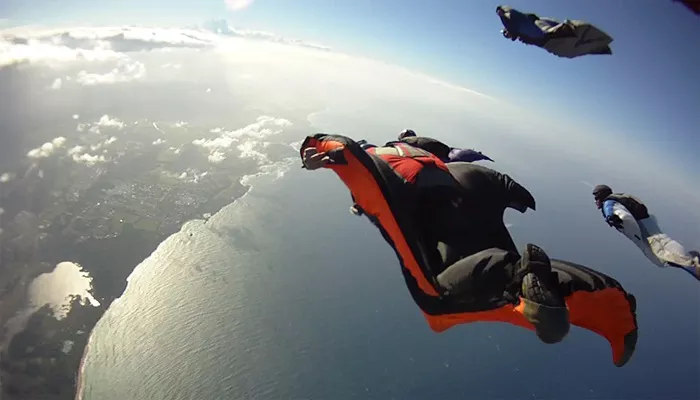Wingsuit flying is an exhilarating and extreme sport that offers the closest sensation to human flight. Combining skydiving skills with the aerodynamics of a specially designed wingsuit, this sport allows enthusiasts to soar through the sky in a controlled, yet thrilling manner. However, it’s not something that can be tackled on a whim. Starting wingsuit flying requires preparation, training, and a careful approach to safety.
In this guide, we’ll walk you through the five essential steps to begin your wingsuit flying journey. Whether you’re an experienced skydiver or a complete beginner to extreme sports, these steps will help you understand what it takes to safely and successfully take the leap into wingsuit flying.
5 Steps To Start Wingsuit Flying
Step 1: Master Skydiving Fundamentals
Before even considering a wingsuit, it’s vital to become proficient in the basics of skydiving. Wingsuit flying requires an exceptional level of control, and that starts with having the proper foundation in skydiving. This is not a beginner sport, and attempting it without first gaining skydiving experience can be extremely dangerous.
What you need to know:
Complete at least 200 solo skydives before attempting wingsuit flying.
Master the art of freefall control, body position, and parachute deployment.
Understand how to handle emergencies like high-speed malfunctions or changes in altitude.
To achieve this, you’ll need to undergo comprehensive training. Enroll in a skydiving school and work with experienced instructors who will guide you through the stages of skydiving. Expect to spend several months (or more) perfecting your jumps before moving on to wingsuit training.
Step 2: Understand Wingsuit Basics
Once you have a strong grasp of skydiving, the next step is to learn the mechanics of a wingsuit. A wingsuit has a unique design that includes fabric wings between the legs and under the arms, which create lift during freefall. This is what allows wingsuit flyers to glide for much longer distances than traditional skydiving.
Key elements to learn about wingsuits:
How wingsuits work in relation to aerodynamics.
The differences between various wingsuit models and how to choose one suited for your body size and skill level.
Proper suit fitting, as the wingsuit must be snug and well-adjusted for safety and performance.
There are a variety of wingsuit styles, from beginner suits with less surface area (for easier control) to more advanced suits that allow for faster speeds and longer flights. Consult experienced wingsuit flyers or instructors to help you select the right model. Additionally, be sure to learn about your suit’s components, like the fabric, zippers, and deployment system, as these all play a role in your safety during jumps.
Step 3: Take Wingsuit Flight Training
Once you’ve completed your skydiving and wingsuit basics training, it’s time for the next step—wingsuit flight training. This is where you’ll receive hands-on instruction on how to operate the wingsuit in freefall, maintain a stable body position, and manage the glide path.
Your wingsuit flight training will include a variety of activities:
Ground school: Learn the principles of flight, body positioning, and emergency procedures.
Simulation jumps: Begin with lower-altitude jumps in a controlled environment to practice the suit’s maneuverability and handling.
Guided flight sessions: Experienced instructors will accompany you during your first wingsuit flights to ensure safety and offer real-time guidance.
During these training sessions, you will focus on mastering control over your glide path, speed, and the suit’s aerodynamic properties. Remember, this phase is crucial for gaining the confidence and skills necessary for more advanced jumps.
Step 4: Gain Experience and Build Confidence
Wingsuit flying, like any extreme sport, requires practice and experience. After completing your training, it’s essential to gain as much experience as possible. Start by doing low-altitude, low-risk jumps and gradually build up your skills. Every jump will give you valuable experience with wind conditions, body control, and wingsuit adjustments.
As you progress, focus on improving specific areas:
Stability: Learn how to adjust your body position to stay level during freefall.
Glide control: Master the art of managing your horizontal flight, so you can glide through the air efficiently.
Altitude awareness: Understand your surroundings, including air traffic and the best landing zones.
It’s also important to jump with a network of experienced wingsuit flyers. This community can provide invaluable insights, tips, and safety checks. As your confidence grows, you’ll gradually be able to perform more advanced maneuvers, such as proximity flying (flying close to mountains or other structures).
Step 5: Prioritize Safety and Continue Learning
Wingsuit flying is a dangerous sport that requires unwavering attention to safety. As with all extreme sports, safety must always be your top priority. There are many risks involved, from equipment malfunctions to challenging weather conditions, so being prepared is essential.
Safety tips for wingsuit flying:
Always check your equipment thoroughly before each jump.
Know the terrain and weather conditions before jumping.
Perform regular maintenance on your wingsuit and parachuting equipment.
Stay in close communication with other jumpers and ground crew.
Continue to take refresher courses and advanced wingsuit training to stay up-to-date with the latest safety procedures.
It’s essential to learn how to handle unexpected situations, such as turbulence, equipment malfunctions, or difficult landings. Never stop practicing your emergency procedures, and always be vigilant during every jump.
Conclusion
Wingsuit flying is an incredible sport that pushes the limits of human flight, but it requires patience, skill, and a commitment to safety. By following these five essential steps—mastering skydiving, understanding wingsuit basics, taking proper training, gaining experience, and always prioritizing safety—you’ll be on your way to enjoying one of the most thrilling sports on the planet.
Start slowly, build your experience, and always be mindful of the risks involved. With dedication and preparation, wingsuit flying can become a truly rewarding experience that will provide you with a sense of freedom and excitement unlike any other.

